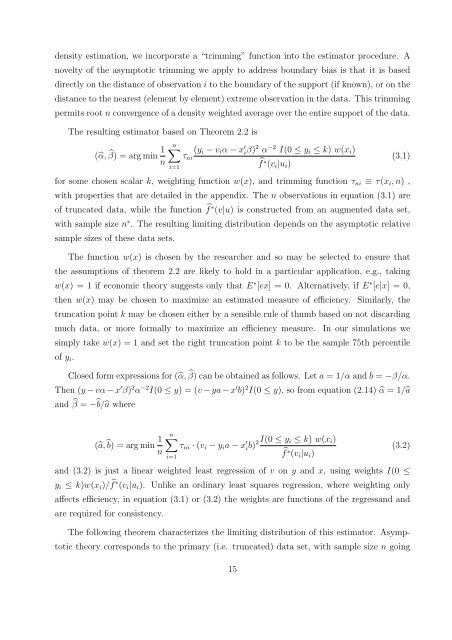weighted and two stage least squares estimation of ... - Boston College
weighted and two stage least squares estimation of ... - Boston College
weighted and two stage least squares estimation of ... - Boston College
You also want an ePaper? Increase the reach of your titles
YUMPU automatically turns print PDFs into web optimized ePapers that Google loves.
density <strong>estimation</strong>, we incorporate a “trimming” function into the estimator procedure. A<br />
novelty <strong>of</strong> the asymptotic trimming we apply to address boundary bias is that it is based<br />
directly on the distance <strong>of</strong> observation i to the boundary <strong>of</strong> the support (if known), or on the<br />
distance to the nearest (element by element) extreme observation in the data. This trimming<br />
permits root n convergence <strong>of</strong> a density <strong>weighted</strong> average over the entire support <strong>of</strong> the data.<br />
The resulting estimator based on Theorem 2.2 is<br />
(α, β) = arg min 1<br />
n (yi − viα − x<br />
τni<br />
n<br />
′ iβ) 2 α−2 I(0 ≤ yi ≤ k) w(xi)<br />
f ∗ (vi|ui)<br />
i=1<br />
(3.1)<br />
for some chosen scalar k, weighting function w(x), <strong>and</strong> trimming function τni ≡ τ(xi, n) ,<br />
with properties that are detailed in the appendix. The n observations in equation (3.1) are<br />
<strong>of</strong> truncated data, while the function f ∗ (v|u) is constructed from an augmented data set,<br />
with sample size n ∗ . The resulting limiting distribution depends on the asymptotic relative<br />
sample sizes <strong>of</strong> these data sets.<br />
The function w(x) is chosen by the researcher <strong>and</strong> so may be selected to ensure that<br />
the assumptions <strong>of</strong> theorem 2.2 are likely to hold in a particular application, e.g., taking<br />
w(x) = 1 if economic theory suggests only that E ∗ [ex] = 0. Alternatively, if E ∗ [e|x] = 0,<br />
then w(x) may be chosen to maximize an estimated measure <strong>of</strong> efficiency. Similarly, the<br />
truncation point k may be chosen either by a sensible rule <strong>of</strong> thumb based on not discarding<br />
much data, or more formally to maximize an efficiency measure. In our simulations we<br />
simply take w(x) = 1 <strong>and</strong> set the right truncation point k to be the sample 75th percentile<br />
<strong>of</strong> yi.<br />
Closed form expressions for (α, β) can be obtained as follows. Let a = 1/α <strong>and</strong> b = −β/α.<br />
Then (y − vα − x ′ β) 2 α −2 I(0 ≤ y) = (v − ya − x ′ b) 2 I(0 ≤ y), so from equation (2.14) α = 1/a<br />
<strong>and</strong> β = − b/a where<br />
(a, b) = arg min 1<br />
n<br />
n<br />
i=1<br />
τni · (vi − yia − x ′ ib) 2 I(0 ≤ yi ≤ k) w(xi)<br />
f ∗ (vi|ui)<br />
(3.2)<br />
<strong>and</strong> (3.2) is just a linear <strong>weighted</strong> <strong>least</strong> regression <strong>of</strong> v on y <strong>and</strong> x, using weights I(0 ≤<br />
yi ≤ k)w(xi)/ f ∗ (vi|ui). Unlike an ordinary <strong>least</strong> <strong>squares</strong> regression, where weighting only<br />
affects efficiency, in equation (3.1) or (3.2) the weights are functions <strong>of</strong> the regress<strong>and</strong> <strong>and</strong><br />
are required for consistency.<br />
The following theorem characterizes the limiting distribution <strong>of</strong> this estimator. Asymp-<br />
totic theory corresponds to the primary (i.e. truncated) data set, with sample size n going<br />
15

















